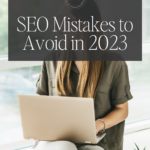
SEO Mistakes to Avoid in 2023
Table of Contents
ToggleSharing is caring!
Reading Time: 4 minutes


SEO is not something you set and forget. You have to measure the metrics regularly to determine which posts perform better than others. You can implement data-based updates based on analytics to create an effective marketing strategy.
To make the most out of your marketing efforts, you must give your SEO campaign a closer look at the end of every year. This helps zero in on changes that will improve your SEO campaign. The rise of AI changed how search engines assess SERPs, something to consider when planning your SEO strategy for 2023.
Changing algorithms can lead to ineffective strategies, and to ensure the success of your
marketing campaign this year, here are some mistakes that you have to avoid in 2023:

7 SEO Mistakes to Avoid in 2023
Deadlinks on Your Website
A website with many links leading to deleted pages can scare away potential leads. It gives the impression that you’re not maintaining your website. It’s also hard for customers to trust your business if you’re not making more effort to update your content links.
More bad news, dead links will also affect your page rankings because Google prioritises well-maintained websites. Google will deem your website untrustworthy, and the search engine will gradually reduce your website’s visibility.
If you don’t want your website to end up at the bottom of the searches, go to your website backend and update your subpages and product pages. Be sure that the links lead to the correct pages.
A Complicated Website Structure
A complex website structure is fine for business, but simple is the best way to go to boost your page rankings. Always remember, a complicated website structure makes optimisation complicated too.
Your readers aren’t the only ones who’ll appreciate the easy navigation – Google’s crawlers also love a simple structure because indexing is more efficient this way. A simple website design is also easier and quicker to update. You can make changes without affecting the functionality or visuals of the website design.
SSL Issues
Data safety and security are essential factors to consider when developing a website. Secure Sockets Layer or SSL is a security protocol that creates a secure connection between two systems.
A website must have an SSL certificate to provide secure data transmission between users and the website. Implement the SSL certificate not just on the main page but on the subpages. Constantly monitor the SSL certificate to make sure it’s working correctly.
Google will only prioritise trustworthy websites. If your website lacks an SSL certificate, making it to the top of the searches will be impossible. Users and search engines deem a website with an SSL certificate as trustworthy.
Page Indexing Issues
Page indexing enhances a website’s online presence. To improve your website visibility, Google and other search engines must index your website pages correctly. But the problem is not all pages are indexed by Google because of issues like 404s, server errors, duplicate content, or biased, thin content.
To prevent page indexing issues, you’ll have to sign up for a Google Search Console account and audit your website pages. From the Google console, go to Consult the Index > to know which of your subpages are not indexed by the search engine. Inspect every URL and request indexing. This will prompt Google to recrawl certain pages for indexing.
Duplicated Content
Duplicated content remains a no-no in SEO, and if you haven’t taken down blogs with duplicate content, better do it now!
Duplicate content confuses search engines. If search engines cannot determine which version of your content is the most authoritative, the website won’t rank as high, even if the content is high quality, original, and relevant. That’s all your hard work down the drain. Duplicated content can also decrease user engagement, leading to poor user experience.
One of the quickest ways to check if your website page has duplicated content, copy about 10 words from the start of a sentence and paste it on Google, then hit search. If several pages contain the exact quote, your website has duplicated content.
Using Heading Incorrectly
Are your blog posts still misusing headings and subheadings? Edit these immediately; otherwise, your online visibility will weaken.
There are different types of HTML headings, and these should be used in the correct format, starting with h1, h2, h3, and so on. Proper heading sequence is vital to SEO because Google establishes the content’s order of importance this way. If you go against this rule, your website will be stuck at the bottom of the searches.
A post should only have one h1, and it indicates what the subpage is all about. The h2 and h3 headings relate to the page source code.
Lacking No-follow Links
Implementing no-follow attributes to build and strengthen your website’s online presence is a must. No-follow links help establish your rankings on Google by keeping the link juice on your website. This will also lead to higher organic traffic from search engines.
On top of that, no-follow links add credibility as far as Google indexing is concerned. Since you’re not boosting your website rankings artificially, your website content will be perceived as more natural and trustworthy by Google.
It’s easy to make simple mistakes if you’re not giving your website content a hard look. Every year, make a habit of auditing your website content and pages – see which ones need a refresh or a complete overhaul.
Most Popular Posts:
Sharing is caring!
PLEASE COMMENT BELOW